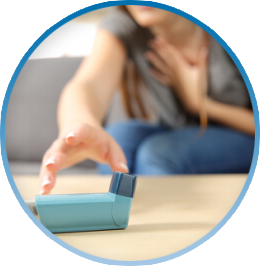The Buteyko Institute Method of breathing retraining was originally known for its role in the management of asthma.
With breathing retraining, many clients experience a decrease in asthma symptom frequency and find that the application of the breathing techniques they learn help them to overcome symptoms when they do occur.
Symptom improvements and reduction in need for medication without loss of lung function, has been demonstrated in published BIM studies. These studies can be viewed on our Clinical Studies page.
What is asthma?
According to Professor Konstantin Buteyko’s work, asthma is not a disease; it is a collection of symptoms, which may include broncho-constriction, inflammation of the bronchial airways and excess mucous.
Why do these symptoms occur?
Many people who get asthma will recognise these scenarios:

You are running late for an appointment. You start to feel anxious. Your pulse rate rises. You huff and puff your way to the top of the stairs. You arrive at your destination breathless and tight chested.
A child’s birthday party: a bag of balloons. You look around for ANYONE else who will blow them up for you because you know that if you attempt it you will have asthma symptoms in no time.
You arrive at your doctor’s office for an appointment. You are asked to perform three ‘Peak Flow’ tests. You blow as hard and fast as you can into the tube – an unpleasant experience. You are asked to repeat the test – this time you start coughing. You repeat the test for the third time. Your chest feels tight; you are breathless and feel exhausted.
Each of the three scenarios outlined above involves a change in your breathing pattern with a sharp increase in the rate and/or depth of breathing. This is called hyperventilation. Put simply – breathing more than the body requires for the current level of metabolic activity. When this occurs it causes an imbalance in the levels of oxygen and carbon dioxide within the lungs and blood. If the level of carbon dioxide becomes too low it is called hypocapnia.
Why does it matter if we breathe out too much carbon dioxide?

There is an optimal level of carbon dioxide that our body needs for optimal functioning. A deficit of carbon dioxide in the body may result in a range of symptoms.
Carbon dioxide is a natural smooth muscle dilator or relaxant. When we have too little carbon dioxide, smooth muscle may go into spasm. Smooth muscle is wrapped around the bronchioles in the lungs and arterial blood vessels. Constriction of smooth muscles lining the bronchioles may produce the chest tightness of asthma and the sensation that breathing is restricted. Constriction of smooth muscle in arterial walls may also contribute to hypertension (high blood pressure), angina and conditions resulting from reduced circulation.
When carbon dioxide falls below an optimal level, reduced oxygen is released from the blood to the cells and tissues (known as the ‘Bohr Effect’ and the ‘Oxy-Haemoglobin Dissociation Curve’). This can be experienced as breathlessness and the feeling like you can’t get enough air.
Mast cells, responsible for part of our immune response, may become super-sensitive to perceived allergens, releasing increased amounts of histamine, producing inflammation.
Over-breathing may dry out the airways possibly leading to inflammation and increased mucous formation.
How can the Buteyko Institute Method of breathing retraining help?
The BIM aims to help people normalise their breathing pattern. When the breathing pattern stabilises and the breathing volume returns to a more normal level, a range of body functions improves as breathing becomes more efficient. Smooth muscle around the airways relaxes and oxygen delivery to the cells is optimised. In addition, histamine and mucous production reduce, helping to lesson inflammation of the airways.
With instruction in the BIM, clients can learn to relieve most asthma symptoms using the breathing exercises. This may enable a reduction in need for bronchodilator medication (reliever puffers such as Ventolin). Asthma management may be improved as fewer symptoms are experienced and therefore less medication is required for optimal control.



